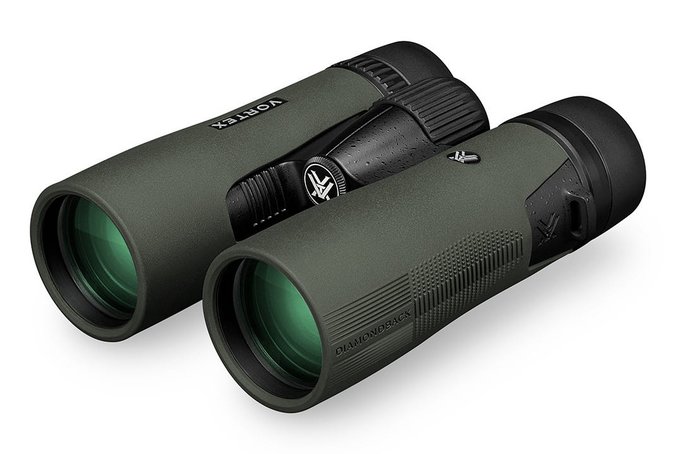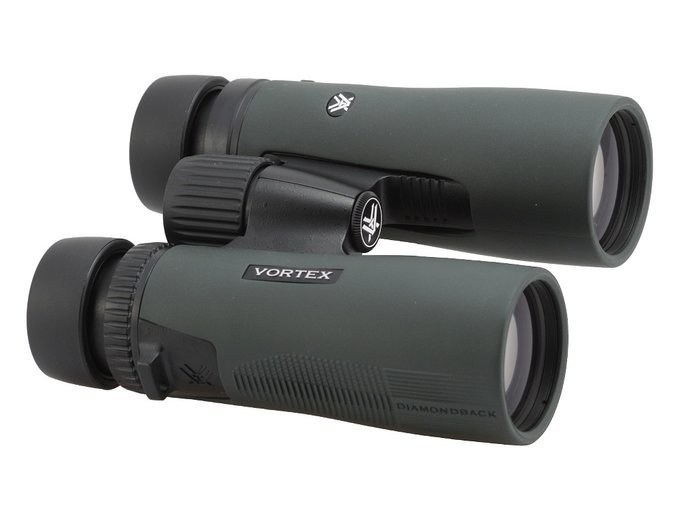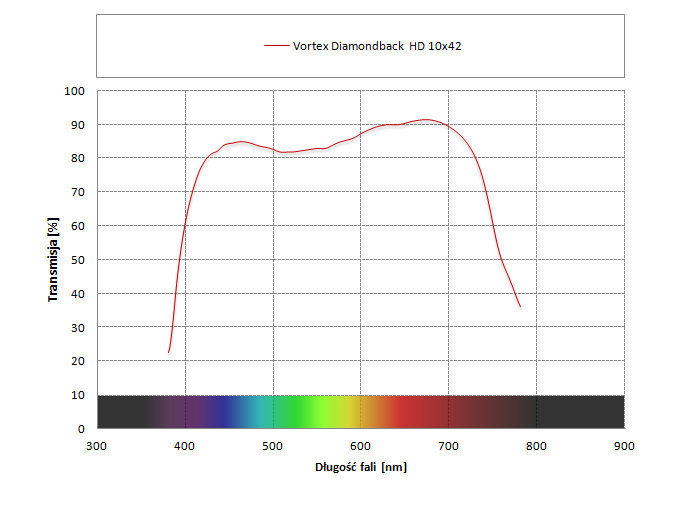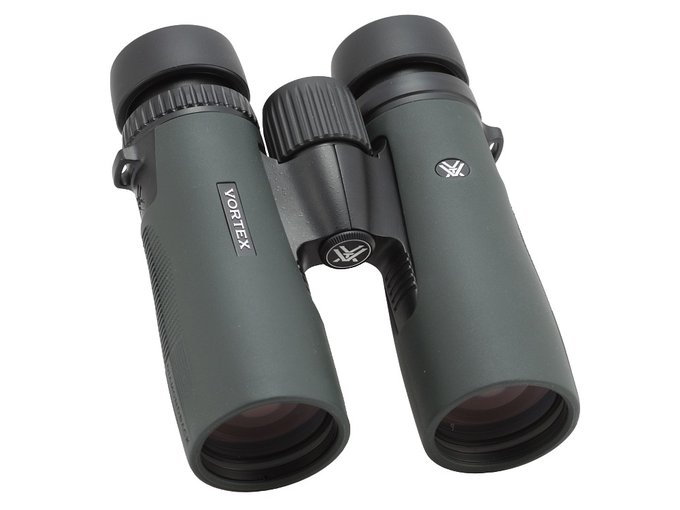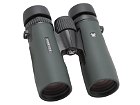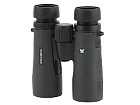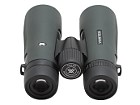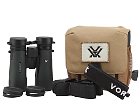| Real front lens diameter |
Left: 42+/-
0.05 mm
Right: 42+/-
0.05 mm
|
8 / 8.0 pkt |
| Real magnification |
9.88+/-
0.05x
|
3/3.0 |
| Transmission |
83.1+/-
1%
|
11/25.0 |
| Chromatic aberration |
Moderate in the centre, distinct on the edge. |
4.7/10.0 |
| Astigmatism |
Very good correction of astigmatism – images of stars sparkle just slightly. |
8.7/10.0 |
| Distortion |
Distance of the first curved line from the field of view centre compared to the field of view radius: 33% ± 5% |
3/10.0 |
| Coma |
Appears in a distance of 70% from the field centre and is between moderate and high values on edges. |
6.2/10.0 |
| Blurring at the edge of the FOV |
Blur occurs in a distance of 77% ± 4% from the field of view centre. |
5/10.0 |
| Darkening at the edge the FOV |
Visible. |
3.2/5.0 |
| Whiteness of the image |
Noticeable dip in the transmission curve in the middle of visible spectrum and a slight surplus of red colour. A tad weaker colouring than in the case of its predecessor.
|
3.9/5.0 |
| Collimation |
Perfect. |
5/5.0 |
| Internal reflections |
| Left: |
Right:
|
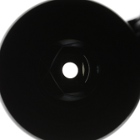 |
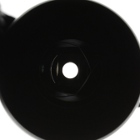 |
Sensibly dark around exit pupils but the situation is worse than in the case of the Diamondback 10x42, tested by us a bit earlier. |
3.4/5.0 |
| Housing |
Very nice and sylish, with sensible dimensions; quite lightweight for the 10x42 class of equipment. Good quality rubber armour which sticks to your hands well. The rubber covering the body fits tight but you can pull it away slightly on objective lenses. Confortable to handle with thumb indents that ensure you a firmer grip; also a joy to look through. No shoddy workmanship. Rubberized eyecups with three regulation positions. Manufactured in China. |
7.5/8.0 |
| Focusing |
A big, ribbed central wheel which moves smoothly but is well damped. The full range needs a turn through an angle of 620 degrees. Dioptre correction done by a ribbed ring on the right eyepiece which is comfortable to use and works properly well. It moves the outer element. |
4.5/5.0 |
| Tripod |
A quite easy access. |
3/3.0 |
| Interpupilary distance |
from 54 to 74.4mm
|
5/6.0 |
| Closest focusing distance |
2.0 meters. |
2/2.0 |
| Eyepieces FOV |
Apparent field of view of 61.8 deg (according to simple formula) and 56.8 deg (according to tangent formula). |
11.5/20.0 |
| Field of view |
Measured by us amounted to 6.26 ± 0.04 degrees and was in accordance with official specifications within the margin of error. A sensible field for this class of equipment.
|
6.5/8.0 |
| Quality of the interior of the barrels |
Inner tubes are gray, not blackened very well. Bottom is gray and quite matt but more black paint would be very useful. Some ribbing and some specks of dust. |
2.8/5.0 |
| Vignetting |
| Left: |
Right:
|
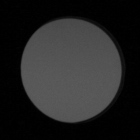 |
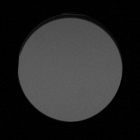 |
OL: 3.50%, OR: 1.48% |
5/8.0 |
| Prisms quality |
Good quality BaK-4. |
8/8.0 |
| Antireflection coatings |
Different shades of green on objectives and eyepieces; prisms are green-yellow. Medium intensity.
|
4.5/5.0 |
| Warranty [years] |
lifetime |
6/6.0 |
| Final result |
69.2%
|
131.4 / 190 pkt
|
| Econo result |
|
0pkt. |
Summary
Pros:
- solid, very nice, and ergonomic casing made of magnesium composites,
- negligible astigmatism,
- sensible colour reindition,
- moderate brightness loss on the edge of the field,
- very clean optics inside the tubes,
- good quality prisms made of BaK-4 glass,
- lifetime warranty.
Cons:
- high chromatic aberration on the edge of the field of view,
- significant distortion,
- blackening inside the tubes could have been better.
At the beginning we should warn our Readers about some inconsistencies concerning the nomenclature of Vortex binoculars. In Viper HD or Razor HD series the HD letters mean that low dispersion glass elements are present in optical system but it is not the case of the Diamondback HD. When it comes to that series the producers inform very obliquely that the system was designed in such a way so it corrects properly chromatic aberration among other things. Very well. On the one hand you might criticize such an approach, I believe a bit misleading for many potential customers. I think a lot of people will be sure that the Diamondback HD models are based on low dispersion glass. On the other hand, though, chromatic aberration can be corrected well also by a well-designed optical system based on ordinary glass so I suppose Vortex shouldn't be criticized too harshly too soon. How did it fare in our test?
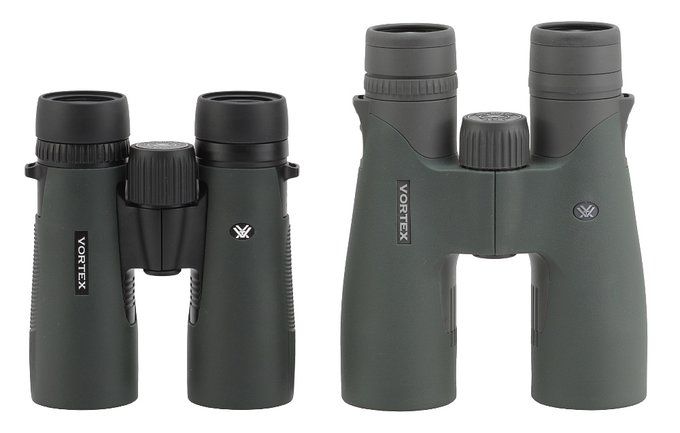
Vortex Diamondback HD 10x42 and Vortex Razor UHD 10x42. |
We won't be writing at length here about the performance of the tested pair of binoculars because the results are quite telling. In the majority of categories the Diamondback HD reached, within the margin of error, the same values as its predecessor. The most important difference concerns the transmission which graph we present below.
The new pair of binoculars features slightly different shades of coatings and, at the same time, you can't notice stronger reflections on one of air-to-glass surfaces in the eyepiece any longer. As a result the overall transmission increased slightly but the graph also became less flat. The dip in the centre of the visible spectrum became more distinct and the same you can say about the surplus of red light. More light reaches our eyes but the colouring is slightly weaker.
There are also some changes in the design of the barrel but most of them are merely cosmetic. Now the producers mention that the barrel is made of magnesium composites – I can't remember whether in the case of the predecessor they stated the same.
We couldn't find more differences. The price of the Diamondback HD is not distinctly higher than the price of Diamondback series devices so you still can buy this pair of binoculars for about 250 Euro. For that reason we basically should repeat our conclusion from our test of the predecessor: for a sensible amount of money you get a shapely, lightweight pair of binoculars and its basic parameters are in perfect accordance with official claims of the producers. We feel such an instrument will be a huge joy to use for anybody needing a 10x42 instrument. Still, for such a sum of money you also shouldn't expect any miracles; there is a fierce competition in that segment so we are sure the Vortex career on the market won't be particularly easy.

